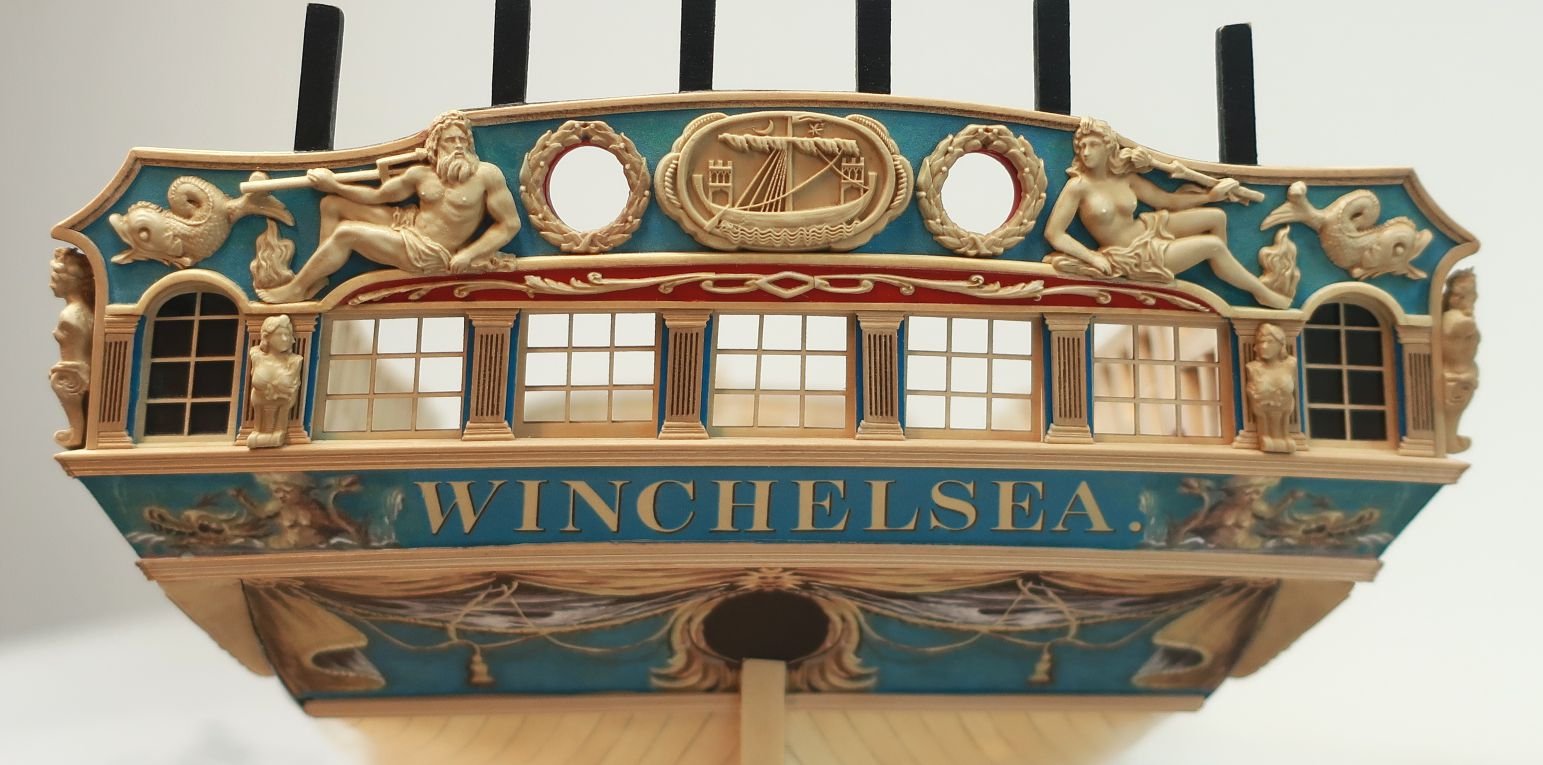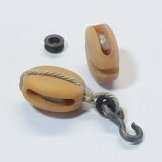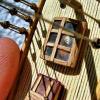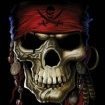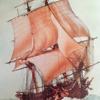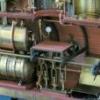-
Posts
9,390 -
Joined
-
Last visited
Reputation Activity
-
 Chuck got a reaction from fatih79 in HM Cutter Cheerful 1806 by Chuck - FINISHED - 1:48 scale - kit prototype
Chuck got a reaction from fatih79 in HM Cutter Cheerful 1806 by Chuck - FINISHED - 1:48 scale - kit prototype
Guys
All I can say is that I am careful and slow to a fault. Its tough to get stuff done this way. But I do agree everyone should just slow down. Its what I recommend a lot of folks to do...
Anyway...back to Cheerful.
I was able after two attempts to shape the boom crutch and create a procedure for doing so. The key was starting with a much thicker piece and making the boom crutch a bit over-sized to start. I cut out the boom crutch on a piece of 1/4" thick boxwood and carefully adjusted for three angles. When completed it will be just 1/8" wide to match the width of the fashion piece. Now that the starboard side is complete I can do the other and take pictures at every step. This is certainly one piece that needs slow and attentive care to the angles involved. The boon crutch must be turned inboard slightly so the boom can actually sit in it. This is tough because the fashion piece and the side of the hull goes in the opposite direction!!! This one piece took me over four hours to produce, shape and paint to a finish I found acceptable.
A few careful reference marks and filing...then turn the piece inward and you are good to go!!! I will have a step by step soon. You can see the second boom crutch over-sized and ready to shape in one of the photos. Note the tail is left long so the proper angles can be created while sanding it shorter.
Because the boom crutch was painted black it might be hard to see in these photos but essentially the boom crutch must match the angle of the fashion piece when viewed from the side and from astern in two planes while being turned to line up with the path of the boom (or the main mast). All while hiding the seam between the two pieces...thank God it is supposed to be painted black.
-
 Chuck got a reaction from CharlieZardoz in HM Cutter Cheerful 1806 by Chuck - FINISHED - 1:48 scale - kit prototype
Chuck got a reaction from CharlieZardoz in HM Cutter Cheerful 1806 by Chuck - FINISHED - 1:48 scale - kit prototype
Guys
All I can say is that I am careful and slow to a fault. Its tough to get stuff done this way. But I do agree everyone should just slow down. Its what I recommend a lot of folks to do...
Anyway...back to Cheerful.
I was able after two attempts to shape the boom crutch and create a procedure for doing so. The key was starting with a much thicker piece and making the boom crutch a bit over-sized to start. I cut out the boom crutch on a piece of 1/4" thick boxwood and carefully adjusted for three angles. When completed it will be just 1/8" wide to match the width of the fashion piece. Now that the starboard side is complete I can do the other and take pictures at every step. This is certainly one piece that needs slow and attentive care to the angles involved. The boon crutch must be turned inboard slightly so the boom can actually sit in it. This is tough because the fashion piece and the side of the hull goes in the opposite direction!!! This one piece took me over four hours to produce, shape and paint to a finish I found acceptable.
A few careful reference marks and filing...then turn the piece inward and you are good to go!!! I will have a step by step soon. You can see the second boom crutch over-sized and ready to shape in one of the photos. Note the tail is left long so the proper angles can be created while sanding it shorter.
Because the boom crutch was painted black it might be hard to see in these photos but essentially the boom crutch must match the angle of the fashion piece when viewed from the side and from astern in two planes while being turned to line up with the path of the boom (or the main mast). All while hiding the seam between the two pieces...thank God it is supposed to be painted black.
-
 Chuck got a reaction from Nirvana in HM Cutter Cheerful 1806 by Chuck - FINISHED - 1:48 scale - kit prototype
Chuck got a reaction from Nirvana in HM Cutter Cheerful 1806 by Chuck - FINISHED - 1:48 scale - kit prototype
The planking above the wales is basically completed. Just a few more planks to add on the port side as you can see. I didnt bother simulating the caulking between the seams where it wont show. So it looks a bit weird now. But once the molding and second layer of the wales is added it will look fine.
You can only see a few places with a crisp line for the seams. This was done by running a number two pencil down one plank edge. If I did this on both plank edges it would have been too pronounced for my tastes.
I will plank the transom and counter next at the stern. Its an interesting detail that in case of a cutter like this you dont plank the stern counter first. The transom and counter are planked after the sides of the hull. The exposed end-grain of the counter planking and transom planking will be protected from the elements and rot by the fashion pieces. You can see them in the profile drawing. So you will not see any of the end grain from the planking. The frame for the square tuck also does this for the end grain of the planks. Its an interesting feature and I almost forgot NOT to plank the counter first. It is something I am so accustomed to doing.
Before I plank the stern transom and counter I have some shaping of the outer stern frames to do. I will post pictures of this as well because its an important feature to keeping the finished model looking accurate. So far its coming together quite well without any real issues. Its a fun build so far. You can start to see the final shape of the cutter come to life as the planking progresses. I know the bulwarks look thick at this point but they will actually be thinned down quite a bit soon. The outboard and inboard planking at the sheer was actually just 1 1/2" thick....once its planked inboard and out the final width will be just 1/8 - 5/32" thick at the most. Closer to 1/8" thick I hope.
-
 Chuck got a reaction from tasmanian in HM Cutter Cheerful 1806 by Chuck - FINISHED - 1:48 scale - kit prototype
Chuck got a reaction from tasmanian in HM Cutter Cheerful 1806 by Chuck - FINISHED - 1:48 scale - kit prototype
Guys
All I can say is that I am careful and slow to a fault. Its tough to get stuff done this way. But I do agree everyone should just slow down. Its what I recommend a lot of folks to do...
Anyway...back to Cheerful.
I was able after two attempts to shape the boom crutch and create a procedure for doing so. The key was starting with a much thicker piece and making the boom crutch a bit over-sized to start. I cut out the boom crutch on a piece of 1/4" thick boxwood and carefully adjusted for three angles. When completed it will be just 1/8" wide to match the width of the fashion piece. Now that the starboard side is complete I can do the other and take pictures at every step. This is certainly one piece that needs slow and attentive care to the angles involved. The boon crutch must be turned inboard slightly so the boom can actually sit in it. This is tough because the fashion piece and the side of the hull goes in the opposite direction!!! This one piece took me over four hours to produce, shape and paint to a finish I found acceptable.
A few careful reference marks and filing...then turn the piece inward and you are good to go!!! I will have a step by step soon. You can see the second boom crutch over-sized and ready to shape in one of the photos. Note the tail is left long so the proper angles can be created while sanding it shorter.
Because the boom crutch was painted black it might be hard to see in these photos but essentially the boom crutch must match the angle of the fashion piece when viewed from the side and from astern in two planes while being turned to line up with the path of the boom (or the main mast). All while hiding the seam between the two pieces...thank God it is supposed to be painted black.
-
 Chuck got a reaction from amateur in HM Cutter Cheerful 1806 by Chuck - FINISHED - 1:48 scale - kit prototype
Chuck got a reaction from amateur in HM Cutter Cheerful 1806 by Chuck - FINISHED - 1:48 scale - kit prototype
Magic!!! Seriously I have no idea...I just work very slooooowly. Drives others nuts when they watch me working on something.
-
 Chuck got a reaction from Leo-zd in HM Cutter Cheerful 1806 by Chuck - FINISHED - 1:48 scale - kit prototype
Chuck got a reaction from Leo-zd in HM Cutter Cheerful 1806 by Chuck - FINISHED - 1:48 scale - kit prototype
Timberheads are completed....now on to the boom crutches. Just a word about those boom crutches. These are probably some of the trickiest parts of the model to make. There are going to be some crazy angles to create and much trial and error. I expect to make quite a large pile of bad boom crutches. This is for the benefit of all those building the model as well. You will no doubt have a large pile of discarded crutches also. I will do my best to explain how I make them step by step.
-
 Chuck got a reaction from archjofo in HM Cutter Cheerful 1806 by Chuck - FINISHED - 1:48 scale - kit prototype
Chuck got a reaction from archjofo in HM Cutter Cheerful 1806 by Chuck - FINISHED - 1:48 scale - kit prototype
Guys
All I can say is that I am careful and slow to a fault. Its tough to get stuff done this way. But I do agree everyone should just slow down. Its what I recommend a lot of folks to do...
Anyway...back to Cheerful.
I was able after two attempts to shape the boom crutch and create a procedure for doing so. The key was starting with a much thicker piece and making the boom crutch a bit over-sized to start. I cut out the boom crutch on a piece of 1/4" thick boxwood and carefully adjusted for three angles. When completed it will be just 1/8" wide to match the width of the fashion piece. Now that the starboard side is complete I can do the other and take pictures at every step. This is certainly one piece that needs slow and attentive care to the angles involved. The boon crutch must be turned inboard slightly so the boom can actually sit in it. This is tough because the fashion piece and the side of the hull goes in the opposite direction!!! This one piece took me over four hours to produce, shape and paint to a finish I found acceptable.
A few careful reference marks and filing...then turn the piece inward and you are good to go!!! I will have a step by step soon. You can see the second boom crutch over-sized and ready to shape in one of the photos. Note the tail is left long so the proper angles can be created while sanding it shorter.
Because the boom crutch was painted black it might be hard to see in these photos but essentially the boom crutch must match the angle of the fashion piece when viewed from the side and from astern in two planes while being turned to line up with the path of the boom (or the main mast). All while hiding the seam between the two pieces...thank God it is supposed to be painted black.
-
 Chuck got a reaction from shipmodel in HM Cutter Cheerful 1806 by Chuck - FINISHED - 1:48 scale - kit prototype
Chuck got a reaction from shipmodel in HM Cutter Cheerful 1806 by Chuck - FINISHED - 1:48 scale - kit prototype
Guys
All I can say is that I am careful and slow to a fault. Its tough to get stuff done this way. But I do agree everyone should just slow down. Its what I recommend a lot of folks to do...
Anyway...back to Cheerful.
I was able after two attempts to shape the boom crutch and create a procedure for doing so. The key was starting with a much thicker piece and making the boom crutch a bit over-sized to start. I cut out the boom crutch on a piece of 1/4" thick boxwood and carefully adjusted for three angles. When completed it will be just 1/8" wide to match the width of the fashion piece. Now that the starboard side is complete I can do the other and take pictures at every step. This is certainly one piece that needs slow and attentive care to the angles involved. The boon crutch must be turned inboard slightly so the boom can actually sit in it. This is tough because the fashion piece and the side of the hull goes in the opposite direction!!! This one piece took me over four hours to produce, shape and paint to a finish I found acceptable.
A few careful reference marks and filing...then turn the piece inward and you are good to go!!! I will have a step by step soon. You can see the second boom crutch over-sized and ready to shape in one of the photos. Note the tail is left long so the proper angles can be created while sanding it shorter.
Because the boom crutch was painted black it might be hard to see in these photos but essentially the boom crutch must match the angle of the fashion piece when viewed from the side and from astern in two planes while being turned to line up with the path of the boom (or the main mast). All while hiding the seam between the two pieces...thank God it is supposed to be painted black.
-
 Chuck got a reaction from Mirabell61 in HM Cutter Cheerful 1806 by Chuck - FINISHED - 1:48 scale - kit prototype
Chuck got a reaction from Mirabell61 in HM Cutter Cheerful 1806 by Chuck - FINISHED - 1:48 scale - kit prototype
Guys
All I can say is that I am careful and slow to a fault. Its tough to get stuff done this way. But I do agree everyone should just slow down. Its what I recommend a lot of folks to do...
Anyway...back to Cheerful.
I was able after two attempts to shape the boom crutch and create a procedure for doing so. The key was starting with a much thicker piece and making the boom crutch a bit over-sized to start. I cut out the boom crutch on a piece of 1/4" thick boxwood and carefully adjusted for three angles. When completed it will be just 1/8" wide to match the width of the fashion piece. Now that the starboard side is complete I can do the other and take pictures at every step. This is certainly one piece that needs slow and attentive care to the angles involved. The boon crutch must be turned inboard slightly so the boom can actually sit in it. This is tough because the fashion piece and the side of the hull goes in the opposite direction!!! This one piece took me over four hours to produce, shape and paint to a finish I found acceptable.
A few careful reference marks and filing...then turn the piece inward and you are good to go!!! I will have a step by step soon. You can see the second boom crutch over-sized and ready to shape in one of the photos. Note the tail is left long so the proper angles can be created while sanding it shorter.
Because the boom crutch was painted black it might be hard to see in these photos but essentially the boom crutch must match the angle of the fashion piece when viewed from the side and from astern in two planes while being turned to line up with the path of the boom (or the main mast). All while hiding the seam between the two pieces...thank God it is supposed to be painted black.
-
 Chuck got a reaction from michael mott in HM Cutter Cheerful 1806 by Chuck - FINISHED - 1:48 scale - kit prototype
Chuck got a reaction from michael mott in HM Cutter Cheerful 1806 by Chuck - FINISHED - 1:48 scale - kit prototype
Guys
All I can say is that I am careful and slow to a fault. Its tough to get stuff done this way. But I do agree everyone should just slow down. Its what I recommend a lot of folks to do...
Anyway...back to Cheerful.
I was able after two attempts to shape the boom crutch and create a procedure for doing so. The key was starting with a much thicker piece and making the boom crutch a bit over-sized to start. I cut out the boom crutch on a piece of 1/4" thick boxwood and carefully adjusted for three angles. When completed it will be just 1/8" wide to match the width of the fashion piece. Now that the starboard side is complete I can do the other and take pictures at every step. This is certainly one piece that needs slow and attentive care to the angles involved. The boon crutch must be turned inboard slightly so the boom can actually sit in it. This is tough because the fashion piece and the side of the hull goes in the opposite direction!!! This one piece took me over four hours to produce, shape and paint to a finish I found acceptable.
A few careful reference marks and filing...then turn the piece inward and you are good to go!!! I will have a step by step soon. You can see the second boom crutch over-sized and ready to shape in one of the photos. Note the tail is left long so the proper angles can be created while sanding it shorter.
Because the boom crutch was painted black it might be hard to see in these photos but essentially the boom crutch must match the angle of the fashion piece when viewed from the side and from astern in two planes while being turned to line up with the path of the boom (or the main mast). All while hiding the seam between the two pieces...thank God it is supposed to be painted black.
-
 Chuck got a reaction from AnobiumPunctatum in HM Cutter Cheerful 1806 by Chuck - FINISHED - 1:48 scale - kit prototype
Chuck got a reaction from AnobiumPunctatum in HM Cutter Cheerful 1806 by Chuck - FINISHED - 1:48 scale - kit prototype
Guys
All I can say is that I am careful and slow to a fault. Its tough to get stuff done this way. But I do agree everyone should just slow down. Its what I recommend a lot of folks to do...
Anyway...back to Cheerful.
I was able after two attempts to shape the boom crutch and create a procedure for doing so. The key was starting with a much thicker piece and making the boom crutch a bit over-sized to start. I cut out the boom crutch on a piece of 1/4" thick boxwood and carefully adjusted for three angles. When completed it will be just 1/8" wide to match the width of the fashion piece. Now that the starboard side is complete I can do the other and take pictures at every step. This is certainly one piece that needs slow and attentive care to the angles involved. The boon crutch must be turned inboard slightly so the boom can actually sit in it. This is tough because the fashion piece and the side of the hull goes in the opposite direction!!! This one piece took me over four hours to produce, shape and paint to a finish I found acceptable.
A few careful reference marks and filing...then turn the piece inward and you are good to go!!! I will have a step by step soon. You can see the second boom crutch over-sized and ready to shape in one of the photos. Note the tail is left long so the proper angles can be created while sanding it shorter.
Because the boom crutch was painted black it might be hard to see in these photos but essentially the boom crutch must match the angle of the fashion piece when viewed from the side and from astern in two planes while being turned to line up with the path of the boom (or the main mast). All while hiding the seam between the two pieces...thank God it is supposed to be painted black.
-
 Chuck got a reaction from Archi in HM Cutter Cheerful 1806 by Chuck - FINISHED - 1:48 scale - kit prototype
Chuck got a reaction from Archi in HM Cutter Cheerful 1806 by Chuck - FINISHED - 1:48 scale - kit prototype
Guys
All I can say is that I am careful and slow to a fault. Its tough to get stuff done this way. But I do agree everyone should just slow down. Its what I recommend a lot of folks to do...
Anyway...back to Cheerful.
I was able after two attempts to shape the boom crutch and create a procedure for doing so. The key was starting with a much thicker piece and making the boom crutch a bit over-sized to start. I cut out the boom crutch on a piece of 1/4" thick boxwood and carefully adjusted for three angles. When completed it will be just 1/8" wide to match the width of the fashion piece. Now that the starboard side is complete I can do the other and take pictures at every step. This is certainly one piece that needs slow and attentive care to the angles involved. The boon crutch must be turned inboard slightly so the boom can actually sit in it. This is tough because the fashion piece and the side of the hull goes in the opposite direction!!! This one piece took me over four hours to produce, shape and paint to a finish I found acceptable.
A few careful reference marks and filing...then turn the piece inward and you are good to go!!! I will have a step by step soon. You can see the second boom crutch over-sized and ready to shape in one of the photos. Note the tail is left long so the proper angles can be created while sanding it shorter.
Because the boom crutch was painted black it might be hard to see in these photos but essentially the boom crutch must match the angle of the fashion piece when viewed from the side and from astern in two planes while being turned to line up with the path of the boom (or the main mast). All while hiding the seam between the two pieces...thank God it is supposed to be painted black.
-
 Chuck got a reaction from Captain Poison in HM Cutter Cheerful 1806 by Chuck - FINISHED - 1:48 scale - kit prototype
Chuck got a reaction from Captain Poison in HM Cutter Cheerful 1806 by Chuck - FINISHED - 1:48 scale - kit prototype
Guys
All I can say is that I am careful and slow to a fault. Its tough to get stuff done this way. But I do agree everyone should just slow down. Its what I recommend a lot of folks to do...
Anyway...back to Cheerful.
I was able after two attempts to shape the boom crutch and create a procedure for doing so. The key was starting with a much thicker piece and making the boom crutch a bit over-sized to start. I cut out the boom crutch on a piece of 1/4" thick boxwood and carefully adjusted for three angles. When completed it will be just 1/8" wide to match the width of the fashion piece. Now that the starboard side is complete I can do the other and take pictures at every step. This is certainly one piece that needs slow and attentive care to the angles involved. The boon crutch must be turned inboard slightly so the boom can actually sit in it. This is tough because the fashion piece and the side of the hull goes in the opposite direction!!! This one piece took me over four hours to produce, shape and paint to a finish I found acceptable.
A few careful reference marks and filing...then turn the piece inward and you are good to go!!! I will have a step by step soon. You can see the second boom crutch over-sized and ready to shape in one of the photos. Note the tail is left long so the proper angles can be created while sanding it shorter.
Because the boom crutch was painted black it might be hard to see in these photos but essentially the boom crutch must match the angle of the fashion piece when viewed from the side and from astern in two planes while being turned to line up with the path of the boom (or the main mast). All while hiding the seam between the two pieces...thank God it is supposed to be painted black.
-
 Chuck got a reaction from gerty in HM Cutter Cheerful 1806 by Chuck - FINISHED - 1:48 scale - kit prototype
Chuck got a reaction from gerty in HM Cutter Cheerful 1806 by Chuck - FINISHED - 1:48 scale - kit prototype
Guys
All I can say is that I am careful and slow to a fault. Its tough to get stuff done this way. But I do agree everyone should just slow down. Its what I recommend a lot of folks to do...
Anyway...back to Cheerful.
I was able after two attempts to shape the boom crutch and create a procedure for doing so. The key was starting with a much thicker piece and making the boom crutch a bit over-sized to start. I cut out the boom crutch on a piece of 1/4" thick boxwood and carefully adjusted for three angles. When completed it will be just 1/8" wide to match the width of the fashion piece. Now that the starboard side is complete I can do the other and take pictures at every step. This is certainly one piece that needs slow and attentive care to the angles involved. The boon crutch must be turned inboard slightly so the boom can actually sit in it. This is tough because the fashion piece and the side of the hull goes in the opposite direction!!! This one piece took me over four hours to produce, shape and paint to a finish I found acceptable.
A few careful reference marks and filing...then turn the piece inward and you are good to go!!! I will have a step by step soon. You can see the second boom crutch over-sized and ready to shape in one of the photos. Note the tail is left long so the proper angles can be created while sanding it shorter.
Because the boom crutch was painted black it might be hard to see in these photos but essentially the boom crutch must match the angle of the fashion piece when viewed from the side and from astern in two planes while being turned to line up with the path of the boom (or the main mast). All while hiding the seam between the two pieces...thank God it is supposed to be painted black.
-
 Chuck got a reaction from yvesvidal in HM Cutter Cheerful 1806 by Chuck - FINISHED - 1:48 scale - kit prototype
Chuck got a reaction from yvesvidal in HM Cutter Cheerful 1806 by Chuck - FINISHED - 1:48 scale - kit prototype
Guys
All I can say is that I am careful and slow to a fault. Its tough to get stuff done this way. But I do agree everyone should just slow down. Its what I recommend a lot of folks to do...
Anyway...back to Cheerful.
I was able after two attempts to shape the boom crutch and create a procedure for doing so. The key was starting with a much thicker piece and making the boom crutch a bit over-sized to start. I cut out the boom crutch on a piece of 1/4" thick boxwood and carefully adjusted for three angles. When completed it will be just 1/8" wide to match the width of the fashion piece. Now that the starboard side is complete I can do the other and take pictures at every step. This is certainly one piece that needs slow and attentive care to the angles involved. The boon crutch must be turned inboard slightly so the boom can actually sit in it. This is tough because the fashion piece and the side of the hull goes in the opposite direction!!! This one piece took me over four hours to produce, shape and paint to a finish I found acceptable.
A few careful reference marks and filing...then turn the piece inward and you are good to go!!! I will have a step by step soon. You can see the second boom crutch over-sized and ready to shape in one of the photos. Note the tail is left long so the proper angles can be created while sanding it shorter.
Because the boom crutch was painted black it might be hard to see in these photos but essentially the boom crutch must match the angle of the fashion piece when viewed from the side and from astern in two planes while being turned to line up with the path of the boom (or the main mast). All while hiding the seam between the two pieces...thank God it is supposed to be painted black.
-
 Chuck got a reaction from albert in HM Cutter Cheerful 1806 by Chuck - FINISHED - 1:48 scale - kit prototype
Chuck got a reaction from albert in HM Cutter Cheerful 1806 by Chuck - FINISHED - 1:48 scale - kit prototype
Guys
All I can say is that I am careful and slow to a fault. Its tough to get stuff done this way. But I do agree everyone should just slow down. Its what I recommend a lot of folks to do...
Anyway...back to Cheerful.
I was able after two attempts to shape the boom crutch and create a procedure for doing so. The key was starting with a much thicker piece and making the boom crutch a bit over-sized to start. I cut out the boom crutch on a piece of 1/4" thick boxwood and carefully adjusted for three angles. When completed it will be just 1/8" wide to match the width of the fashion piece. Now that the starboard side is complete I can do the other and take pictures at every step. This is certainly one piece that needs slow and attentive care to the angles involved. The boon crutch must be turned inboard slightly so the boom can actually sit in it. This is tough because the fashion piece and the side of the hull goes in the opposite direction!!! This one piece took me over four hours to produce, shape and paint to a finish I found acceptable.
A few careful reference marks and filing...then turn the piece inward and you are good to go!!! I will have a step by step soon. You can see the second boom crutch over-sized and ready to shape in one of the photos. Note the tail is left long so the proper angles can be created while sanding it shorter.
Because the boom crutch was painted black it might be hard to see in these photos but essentially the boom crutch must match the angle of the fashion piece when viewed from the side and from astern in two planes while being turned to line up with the path of the boom (or the main mast). All while hiding the seam between the two pieces...thank God it is supposed to be painted black.
-
 Chuck got a reaction from wyz in HM Cutter Cheerful 1806 by Chuck - FINISHED - 1:48 scale - kit prototype
Chuck got a reaction from wyz in HM Cutter Cheerful 1806 by Chuck - FINISHED - 1:48 scale - kit prototype
Guys
All I can say is that I am careful and slow to a fault. Its tough to get stuff done this way. But I do agree everyone should just slow down. Its what I recommend a lot of folks to do...
Anyway...back to Cheerful.
I was able after two attempts to shape the boom crutch and create a procedure for doing so. The key was starting with a much thicker piece and making the boom crutch a bit over-sized to start. I cut out the boom crutch on a piece of 1/4" thick boxwood and carefully adjusted for three angles. When completed it will be just 1/8" wide to match the width of the fashion piece. Now that the starboard side is complete I can do the other and take pictures at every step. This is certainly one piece that needs slow and attentive care to the angles involved. The boon crutch must be turned inboard slightly so the boom can actually sit in it. This is tough because the fashion piece and the side of the hull goes in the opposite direction!!! This one piece took me over four hours to produce, shape and paint to a finish I found acceptable.
A few careful reference marks and filing...then turn the piece inward and you are good to go!!! I will have a step by step soon. You can see the second boom crutch over-sized and ready to shape in one of the photos. Note the tail is left long so the proper angles can be created while sanding it shorter.
Because the boom crutch was painted black it might be hard to see in these photos but essentially the boom crutch must match the angle of the fashion piece when viewed from the side and from astern in two planes while being turned to line up with the path of the boom (or the main mast). All while hiding the seam between the two pieces...thank God it is supposed to be painted black.
-
 Chuck got a reaction from mtaylor in HM Cutter Cheerful 1806 by Chuck - FINISHED - 1:48 scale - kit prototype
Chuck got a reaction from mtaylor in HM Cutter Cheerful 1806 by Chuck - FINISHED - 1:48 scale - kit prototype
Magic!!! Seriously I have no idea...I just work very slooooowly. Drives others nuts when they watch me working on something.
-
 Chuck reacted to druxey in HM Cutter Cheerful 1806 by Chuck - FINISHED - 1:48 scale - kit prototype
Chuck reacted to druxey in HM Cutter Cheerful 1806 by Chuck - FINISHED - 1:48 scale - kit prototype
Sawdust Dave: All I was trying to say was consider the idea: I wasn't pushing that you go in that direction. I certainly didn't mean to criticize your work! If you took me wrong, I apologize. Please don't immolate anyone!
-
 Chuck got a reaction from qwerty2008 in HM Cutter Cheerful 1806 by Chuck - FINISHED - 1:48 scale - kit prototype
Chuck got a reaction from qwerty2008 in HM Cutter Cheerful 1806 by Chuck - FINISHED - 1:48 scale - kit prototype
Magic!!! Seriously I have no idea...I just work very slooooowly. Drives others nuts when they watch me working on something.
-
 Chuck reacted to druxey in HM Cutter Cheerful 1806 by Chuck - FINISHED - 1:48 scale - kit prototype
Chuck reacted to druxey in HM Cutter Cheerful 1806 by Chuck - FINISHED - 1:48 scale - kit prototype
So, consider a little change in direction, Sawdust Dave. Do you want to leave five sub-standard models or one really good one? I know which way I jump!
-
 Chuck got a reaction from fatih79 in HM Cutter Cheerful 1806 by Chuck - FINISHED - 1:48 scale - kit prototype
Chuck got a reaction from fatih79 in HM Cutter Cheerful 1806 by Chuck - FINISHED - 1:48 scale - kit prototype
Timberheads are completed....now on to the boom crutches. Just a word about those boom crutches. These are probably some of the trickiest parts of the model to make. There are going to be some crazy angles to create and much trial and error. I expect to make quite a large pile of bad boom crutches. This is for the benefit of all those building the model as well. You will no doubt have a large pile of discarded crutches also. I will do my best to explain how I make them step by step.
-
 Chuck got a reaction from Gahm in HM Cutter Cheerful 1806 by Chuck - FINISHED - 1:48 scale - kit prototype
Chuck got a reaction from Gahm in HM Cutter Cheerful 1806 by Chuck - FINISHED - 1:48 scale - kit prototype
Timberheads are completed....now on to the boom crutches. Just a word about those boom crutches. These are probably some of the trickiest parts of the model to make. There are going to be some crazy angles to create and much trial and error. I expect to make quite a large pile of bad boom crutches. This is for the benefit of all those building the model as well. You will no doubt have a large pile of discarded crutches also. I will do my best to explain how I make them step by step.
-
 Chuck got a reaction from cristikc in Block layout for Syren foremast and mainmast tops
Chuck got a reaction from cristikc in Block layout for Syren foremast and mainmast tops
Doubles on the inside and singles on the outside.....
-
 Chuck got a reaction from riverboat in Block layout for Syren foremast and mainmast tops
Chuck got a reaction from riverboat in Block layout for Syren foremast and mainmast tops
Doubles on the inside and singles on the outside.....

